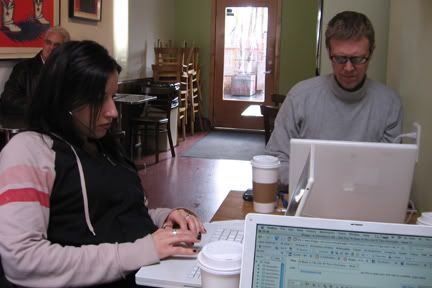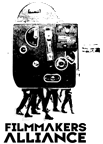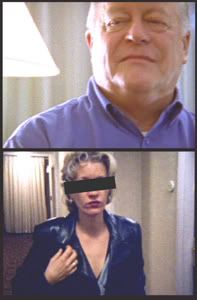Monday, February 25, 2008
RED Camera Workflow
Click HERE to read it.
Best,
J.
Saturday, February 23, 2008
Web Movies Show Why DVDs Sell
WEB MOVIES SHOW WHY DVDs SELL
By DAVID POGUE
Ten days ago, Netflix announced that it would abandon HD DVD, Toshiba's entry in the high-definition DVD format war. Six days ago, Wal-Mart dropped HD DVD, too. Then two days ago, Toshiba surrendered, marking the end of the most pointless format war since Betamax-VHS.
Man, if they have Friday beer bashes over at Toshiba, this week's will be a real downer.
Why did so many companies dump HD DVD so fast? Intriguingly, one often-cited reason is the approaching era of Internet movie downloads. The logic goes like this: as long as there's a format war, consumers won't buy DVD players of either type. By settling on a single format - it doesn't really matter which one - the movie and electronics industries can at least start milking the remaining years of the DVD's life.
In fact, though, the Internet movie download era is more distant than pundits think, for four colossal reasons.
First, downloadable movies require high-speed Internet connections - and only about half of American households have them. That number won't change much for years.
Second, downloaded movies don't include the director's commentaries, deleted scenes, alternate endings, alternate language soundtracks or other DVD goodies. It's just not as rich an experience.
Third, movie downloads don't deliver the audio and video quality of DVD discs - even standard-def ones. Internet movies are compressed to download faster, which affects picture quality, and offer older, more compressed audio soundtracks than modern DVDs. (Check out the astounding quality-comparison photos at http://tinyurl.com/3e488m for details.)
Finally, today's movie-download services bear the greasy policy fingerprints of the movie studio executives - and when it comes to the new age of digital movies, these people are not, ahem, known for their vision.
For example, no matter which movie-download service you choose, you'll find yourself facing the same confusing, ridiculous time limits for viewing. You have to start watching the movie you've rented within 30 days, and once you start, you have to finish it within 24 hours.
Where's the logic? They've got your money, so why should they care if you start watching on the 30th day or the 31st?
Then there is the 24-hour limit. Suppose you typically do not start a movie until 7:30 p.m., after dinner and the homework have been put away. If you do not have time to finish the movie in one sitting, you cannot resume at 7:30 tomorrow night; at that point, the download will have self-destructed.
What would the studios lose by offering a 27-hour rental period? Or three days, or even a week? Nothing. In fact, they'd attract millions more customers. (At the very least, instead of just deleting itself, the movie should say: "Would you like another 24-hour period for an additional $1?")
Then there's the fact that to protect their cash cows, most studios don't release their movies on the Internet until a month after they've been available on DVD.
Despite these limitations, plenty of companies are staking out property on the digital-download frontier. Some deliver movies to your computer screen, which will never appeal to anybody but nerds; virtually nobody gathers the family 'round the old Dell on movie night.
Several boxes, however, deliver movies straight to your TV, usually for $3 to $5 each. Here are their report cards.
Apple TV ($230). Thanks to a free software upgrade, Apple's sleek little box has taken on a whole new life. It now connects directly to the iTunes store - no computer needed. Movies are stored on the Apple TV's internal hard drive.
Standard-def movies begin to play only a few seconds after you've selected them; you watch the beginning while the rest is downloading. High-def movies take several minutes to begin playing.
In a couple of years, Apple TV may be the box to beat. The movie store is fun to navigate, picture quality is high and wireless networking is built-in, unlike its rivals. You can buy episodes from any of 650 TV series on demand (usually $2 an episode, no ads), which its competitors can't touch. Finally, of course, the Apple TV does a lot of other stuff; it can display all the music, pictures and movies from your Mac or PC and play podcasts and videos from the Web.
But the Apple TV movie store's shelves look a little bare. Fewer than 1,000 movies are available, and only 100 are in high definition; compare with the 90,000 titles offered by Netflix on DVD, 900 in high-def. (Apple points out that its store's music catalog started out tiny, too - 200,000 songs, compared with 6 million today.) There are some silly bugs in the debut software, too.
Instant gratification: A-. Selection: D. Overall movie joy: B.
TiVo/Amazon Unbox ($100 and up, plus monthly fee). Here's another box whose original purpose was something other than movie downloads. But among its blossoming portfolio of video features, TiVo lets you rent or buy movies downloaded from Amazon.com's Unbox service.
At least you no longer have to order these movies at Amazon.com (although you can, using your Mac or PC, if you prefer to type movie titles with a real keyboard instead of fussing with on-screen alphabets). You can do the whole transaction right from the couch.
Show time is not instantaneous, either; on high-def TiVos, you can't start watching until 10 minutes after you order, and on older models, you have to wait for the whole movie to download (1 to 5 hours). Selection is still slim: 3,200 movies are available to rent; 4,700 available to buy. None are in high definition.
Instant gratification: B-. Selection: C. Overall movie joy: B-.
Xbox 360 ($350 and up). Yet again, here's a box whose movie service isn't the primary attraction (here, it's games). In this case, though, the movie thing isn't just secondary - it's way, way down the list.
You have to watch movies within 14 days, not 30. The remote control isn't designed for video playback. You pay using a confusing system of Microsoft "points," which you must buy in $5 increments. And although there are plenty of TV shows available, only 300 movies are in the catalog at any given time, about half in high definition.
Instant gratification: A-. Selection: D. Overall movie joy: D.
Vudu ($300). This compact black box comes loaded with the beginnings of 5,000 movies. When you rent or buy one, therefore, playback begins instantly. About 20 new movies arrive on the box each week, pushing older ones off the 250-gigabyte hard drive.
Vudu is the only dedicated movie box . The interface is pure and clean, picture quality is tops and the remote has only four buttons (plus a terrific scroll wheel).
On the downside, many of those 5,000 movies are pure direct-to-video dreck (anyone for "San Franpsycho" tonight?). Confusingly, movies on the list come and go according to Vudu's deals with the studios. And you need a pretty fast connection; basic DSL subscribers need not apply.
Instant gratification: A. Selection: B+. Overall movie joy: B+.
When competing with the humble DVD, Internet movie boxes do poorly on price, selection and viewing flexibility (that is, how much time you have to watch). Their sole DVD-smashing feature is the convenience; you get the movie right now.
Meanwhile, other sources of instant movie gratification are emerging. Comcast, the nation's largest cable TV company, offers 1,000 on-demand movies each month, many of them free; by year's end, it intends to increase that number to 6,000 (half in high-def) - and you don't have to buy a special box.
The point is that the whole Internet-movies thing is still in its fumbling, bumbling infancy; someday, we'll look at these limited-selection, limited-time services and laugh.
In the meantime, congratulations to Blu-ray, the winning next-generation DVD format. Clearly, spinning silver discs will remain the dominant movie-delivery method for years to come.
This article has been revised to reflect the following correction:
Correction: February 22, 2008
The State of the Art column in Business Day on Thursday, about movie downloading, referred incorrectly in some editions to a feature of the
Thursday, February 21, 2008
A Week In The Life Of This Filmmaker - Week 7
So, I'll pick a week once a month. This way, I can just point out the filmmaking-relevant activities each day and, therefore, more precisely continue to paint a picture for other filmmakers of how I maintain and manage a filmmaker's life.
Sunday, February 10th to Saturday February 16th, 2008
Sunday - The Filmmakers Alliance Meeting - Wow. It was packed. We did a seminar by Marc Rosenbush who does the Internet Marketing For Filmmakers course. That's the self-empowering future for us filmmakers. And technical problems aside, the seminar went great. Afterward, Marc, his business partner, Fred Kramer from Withoutabox and I all went out to dinner and strategized about how to best support filmmakers through distribution. It was very exciting and inspiring and I got back just in time for the end of the FA meeting. Well, in time for the reception that ends each meeting. Just in time to party. That's me.
Monday - Working regularly in the FA office. Ridiculous amount of emails to send and return. Mostly around sponsorship for 5 Minute Film School. Started drafting part 2 of the FA Fundraising letter. According to marketing wisdom, gotta send out 3-5 of them to get people to pay attention. Personally, I find it incredibly annoying to receive 3-5 missives about anything. But if people marketed to people like me, they wouldn't make much money. So, I'll follow the plan because it seems to work with "normal" people.
Tuesday - Morning writing session. I think I mentioned it before. Twice a week, I get up to meet Sean, Amanda and Cain (Tuesdays only) at 6 a.m. at a coffee shop to write. Tuesday on one side of town and Thursday on the other. We aren't writing anything together. Just motivating each other to write our individual pieces.

Only lately, I've been writing all kinds of other stuff - this blog, an e-book, business proposals, emails, etc. There's been a real need to focus on income generation for all of my various activities, so the creative stuff has had to take a back seat. But there is something else. I feel creatively dry. I've not only been avoiding the creative stuff, it also just isn't coming. And, it's finally starting to get to me. It's been over 2 years since I made my last film, the short "Transaction". I'm starting to feel more like a businessman than a filmmaker. But in the shower this morning, my mind starts drifting toward all kinds of story ideas - a profusion of them bursting out of my head faster than I can acknowledge them. I write down everything I can remember immediately after the shower. This is a good sign. I feel like I've had a successful day already and the other bullshit work I have to do seems almost pleasant.
Wednesday - Met with my friend, Linda Miller (who also produced my feature, "The Dogwalker"), for lunch. She's Vice-President of Physical Production at Yari Film Group. Actually, because there's no President, she heads up Physical Production. We discussed how our company, FA Productions, might jump into doing bigger-budgeted films for YFG. Linda had some great ideas and made the proper introductions for me. I'm confident we'll find something to do with them. Am I selling out? Yes, a bit I guess. But I liken it to Orson Welles's acting career (sheesh, now I'm comparing myself to Orson Welles...oh, lordy). He sometimes did ridiculous acting gigs because it gave him the financial freedom to pursue his other creative passions - most notably his directing work. For me, producing is a day job. It's not that I don't care at all about what I produce - it cannot be spiritually objectionable to me - I just don't have to have the same kind of burning passion for the material that I would need to have if I were directing it. Of course, I ideally would ONLY produce films for which I had that burning passion. But those don't come along so often. Anyway, since putting a film together is such a nasty b****, why hustle and scrape to do itty bitty films when I can do the same hustling and scraping to do films that will earn me much more per film? Of course, I will still want to do some of those itty bitty films because they will sometimes fill me with burning passion. But that is not all I have to do. There, I've convinced myself I'm not a complete sell-out. Prove to me I'm wrong.
Thursday - Back in the office, suddenly feeling pressure to finish addressing paperwork issues on both "Within" and "Midnight Movie". The films were produced through Bigfoot Entertainment, which is a privately held company but operates like a small studio. Independent filmmakers are not known for their anal-retentiveness when it comes to paperwork (although there are plenty of exceptions). But it is important to a small studio. So, we've had to clean up a ton of loose ends over the last few months. It's daunting because all of the producers, including myself, have to contend with tons of other distractions - like making a living. Granted, it should have been done right the first time. And dealing with it now, I'm really sorry it wasn't. Lesson learned. Anyway, I dig into it again. Ever so slowly clearing the weeds....

Also, I meet with one of our new investors for FA Productions. Things are moving forward. That's all I'll say for now. All good.
Friday - Follow-up call Friday. I often reserve Friday for making a furious blitz of follow up phone calls. You just can't depend on email alone when trying to connect with people. Been trying to hook up with the YouTube folk to pitch them on one of my film-related, but non-filmmaking, projects - 5 Minute Film School. They are harder to get hold of than major celebrities. That's because they've cloaked themselves in privacy the same way, but don't have agents and managers to act as their representatives. Even though we've been already been pledged a massive bit of support (which I cannot yet discuss), we still need key sponsors and resource partners. And YouTube is perfect partnership fit for 5MFS. I'll eventually get them, though. When that obsessive, feverish determination grabs me, I rarely can be stopped.
Saturday - More emails. More proposals. All the stuff I need to do that doesn't require being done during business hours. I also have time to contemplate things, a bit. Life has been challenging for me over the past year in ways I don't wish on anyone. You'd think that would be fodder for creativity, but it hasn't been. Too painfully distracting. Or maybe it is fodder, but only now that I've had time to process it, now that I feel I'm turning a corner a bit. I tinker with my ideas for new films. I feel creative juices starting to flow, again. That feels good....
Thursday, February 14, 2008
The Birth of Ideas
Then again, some filmmakers look at things as we've seen them a bezillion times and ask, "why do I have to come up with something different"?
I get truly disheartened going to films and being fed the same old stale piece of bread. Sometimes it has butter on it, sometimes cheese, sometimes peanut butter, sometimes jam (even various kinds of jam)....but underneath it all is still a stale old piece of bread. I sort of expect it with studio films, which are, for the most part, the Wonder Bread of cinema. But now, I see it with so-called indies.

And that lack of freshness and lack of inspiriation can often be found not just in the story and various hackneyed "plot points" - but also in the characters, the dynamics between them, the composition, the lighting, color, camera moves, etc.
Unfortunately too many filmmakers steal their ideas from other films. Don't get me wrong. I think steeping yourself in great filmmaking is essential to understanding the possibilities of cinema. It's said (apocryphally, I'm sure) that Orson Welles watched John Ford's "Stagecoach" something like 35 times before he made "Citizen Kane". But I doubt you'll ever confuse the two films. Cinema is like any other language. You learn it so you can express yourself in your own unique voice. At least, that is the idea, from my perspective. Yet, too many filmmakers utilize only small portions of the languange and repeat it ad nauseum - becoming nothing more than parrots, sitting in their gilded cages spitting out films that say "Polly wants a cracker" (actually, your money) until you are numb and, ultimately, compliant.
Sure, anybody can bitch about mediocrity. But how easy is it to come up with new ideas and points of view? Where do we find them? Well, our imaginations, of course. And if you don't have imagination, you shouldn't be making films. Or creating anything new, really. Of course, if this were true, we'd be putting an entire "industry" out of work. But it's not enough to have an imagination. Something needs to spring forth from it and be translated into a film. This is where maternal instincts are important for developing fresh ideas. Because they are like babies. They can be born or adopted. But they need to be nurtured and made your own. So, when ideas, thoughts, fantasies, possiblities or anything of the sort spring into your head, apply some basic principals of motherhood to them.
- Any father is a good father. In the wild, if a male of the species reaches the point where he can impregnate a female, he has already proven his evolutionary worthiness. If an idea has made it to your consciousness, it has already proven its worth. Don't question where ideas come from. Just be thankful they exist.
- Do not use contraception. Meaning, allow for your thoughts to become fertilized. Don't stop yourself from thinking...well, anything. It doesn't mean you're a pervert or a freak. Well, maybe you are, but that can work to your advantage if you express that energy cinematically as opposed to in any other way.
- Allow them to come full term. Don't censor your ideas and thoughts. Let them develop fully. Let them shape themselves. Let them mutate, if necessary. The good thing about ideas (as opposed to real babies) is that the more twisted and fucked up they are, the better.
- Nourish them. When you get a germ of an idea, feed it with possibilities. Add other elements to it. Put it in different contexts. Color, shade, and shape it. See it in reverse. Imagine its opposite.
- Do not judge them. Whether you are birthing or adopting an idea, do not judge it. You must love your ideas unconditionally in their formative moments. No idea is a bad idea. Let yourself nurture its potential so that you can appreciate it in a fully realized state.
- Protect them until they can protect themselves. Although it is important to share ideas and open them up to feedback/criticism, avoid doing it too early. Make sure the idea is clear in your head - that it is fully what it needs to be - before allowing it to experience the vicissitudes of creative evolution.
- Allow them to define themselves. Let them grow into the unique and distinct ideas that they can become. Too much controlling influence will homogenize and sterilize them. If an idea seems to be taking you down an unanticipated road, go along for the ride for awhile. There's always the chance you may wind up in an unexpectedly better place than the one you had pre-determined for yourself.
- Know when to kill your babies. Harsh metaphor, I know. But a popular one in the writing world and sickeningly appropriate for this post. But it is important to accept that when all is said and done, your idea may not work for you. Don't let it go too early, but don't hang on too long, either. There's no hard and fast rule for knowing when you reach the right point. You just have to be aware that you are banging your head against the wall and, eventually, you will organically know when it is time to put the idea up for adoption. Or snuff it out completely.
But before that ugly decision faces you, open yourself up to new ideas and fresh perspectives, then embrace, love and nurture them no matter how odd they may feel to you. In fact, especially if they feel odd to you. Because any great film has, at its core, a crucial oddity....and uses cinema to express that oddity as art.
Saturday, February 9, 2008
Poetic Logic vs. Narrative Logic - The "Sophie's Choice" of filmmaking
Poetic logic vs. Narrative Logic.
Maybe not as exciting as a WWF smack-down, but in some ways, profoundly more impactful, culturally. Not that poetic logic and narrative logic are mutually exclusive - in fact some of the best films integrate the two beautifully - but there are definitely times in these great films where the filmmaker has had to serve one over the other. And often, it is specifically that choice that has determined the greatness of the film.

Film is often spoken synonymously with story-telling. I agree with this whole-heartedly if the definition of story-telling includes poetic logic and dream logic. But typically, when people discuss story-telling, they are referring to rather straight-forward narrative construction. Yes, film is indeed a great medium for acting out straight-forward narratives. It takes a story that could be conveyed by someone just sitting and verbalizing it and applies the specific properties of cinema to give it depth and dimension. Good story-tellers are always compelling, but realizing a good story through the skillful application of the tools of cinema definitely takes story-telling to the next level.
But why is that the case? And what else should the properties of cinema be in service of if not the demands of straight-forward narrative construction? The answer to both questions is the same: Poetry/Dreams.
Story-telling affects us on a conscious level, and that can be compelling enough, indeed. But the properties of cinema take story-telling to the level of the sub-conscious...to the level of dreams, if you will. And that is why films can affect us so powerfully - because it can touch us in a really deep place, in ways beyond our awareness. A film only rises to the level of art when it can speak powerfully to the sub-conscious.
Poetic logic and Dream logic are ways of telling stories that acknowledge that practically everything in life or imagination is a symbol or metaphor. They are doorways to a deeper understanding of things or they are triggers for deeper emotions.
And that is done through sound, images and emotive energy, primarily. As well as the arrangement and juxtaposition of those elements. Rarely is our sub-conscious at all impacted by dialogue and plot, except as a framework for managing these other elements. You've probably heard it said that there are a finite number of stories to tell (in terms of story construction, not specific detail). Well, that's because what we can create or embrace from a conscious perspective is finite. What we can create or embrace in our sub-conscious/unconscious selves is infinite. Narrative convention is fraught with patterns and rules of construction. Poetry and dreams are like fingerprints. They constantly create new patterns, rather than being defined or constricted by them.
This is not to say that dialogue and plot are unimportant. They, too, can be created in a way that speaks directly to the sub-conscious. But sometimes they are simply important as a doorway to the sub-conscious. Meaning, some people will not let you speak to their sub-conscious if you don't speak to their conscious selves first. The people who don't get "arty" films and get annoyed with experimentalism often need the safety of narrative conventions before they can allow themselves to respond to anything deeper than that.
But as I said, there are times when we filmmakers have to make a choice about which of the two is the child we must keep. One is tried and true, safe and familiar. The other is deep and mysterious. One can be agonizingly predictable and uninspiring. The other can be maddeningly esoteric. One has clear rules to follow, the other has a logic that must be created by the filmmaker. It is a filmmaker's choice to make. However, I don't know of a great film - a film that truly stands as a work of art - that did not, in the end, serve poetry over narrative convention.
More Distribution Information and Excitement
THE NEW AGE OF INDEPENDENT DISTRIBUTION
by Peter Broderick
A revolution in distribution is well underway. The old rules no longer apply, but most distributors continue to do business as if little has changed. Many filmmakers don't yet fully understand the unprecedented opportunities newly available to them.
Before the revolution, it was the Age of Dependent Distribution. The studios and other distributors were in full control. As gatekeepers and middlemen, they controlled access to audiences in a top-down distribution system. Filmmakers approached them as supplicants, offering them exclusive control of their films in one sector (such as television or home video) or all sectors. There were a few exceptions, such as filmmakers who self-distributed their films theatrically, and New Day Films, the filmmaker co-op focused on educational distribution.
The vast majority of filmmakers became totally dependent during distribution. Many sought overall deals, giving one company all of their distribution rights in North America for 15 to 25 years. Although many filmmakers who made overall deals ended up unhappy, this didn't deter others from pursuing such deals.
Things changed very little following the digital revolution in production. The availability of affordable digital cameras and software enabled filmmakers to own the means of production for the first time. They could now be truly independent while making their films. But when it came to distribution, old ways and attitudes continued. However proactive and tenacious filmmakers were when willing their films into existence, most became reactive and cautious when bringing them into the world, simply choosing among the conventional distribution offers they received.
A new Age of Independent Distribution is dawning, allowing filmmakers to maintain greater control of their distribution than ever before. Creative distribution strategies are enabling them to get their films out more widely, earn more money and have greater political impact than would be possible through traditional distribution deals. Some filmmakers have netted over $1 million selling a single film from their website.
This new Age of Independent Distribution provides unprecedented opportunities. It gives filmmakers:
Direct Access to Viewers
Filmmakers can sell DVDs and digital downloads directly to consumers from their websites, build a mailing list of buyers and subscribers, communicate with them regularly and benefit from their referrals and suggestions.
Global Distribution
Filmmakers can make their films available to anyone with Internet access anywhere in the world. They can supplement deals made by their foreign sales agents by allowing consumers in unsold territories to order directly from their websites.
Access to Target Audiences
Filmmakers can identify, reach and sell to niche audiences via online and offline partnerships in ways never before possible. They can partner with websites and organizations to exchange links, engage in affiliate marketing and organize house parties across the country.
Direct Revenue Flow
Filmmakers can make much greater profit margins on DVDs sold directly from their websites (as compared with DVDs sold in retail). They can also sell from their websites other versions of a film and related products (books, CDs, T-shirts), as well as past work.
Hybrid Distribution
Filmmakers can maximize sales and limit cross-collateralization by retaining the right to sell directly from their websites and splitting other rights among capable distribution partners.
A Core Personal Audience
Filmmakers can build and nurture a base of supporters for past, current and future work. They can build relationships with customers, converting them from consumers to supporters and mentors.
Greater Control of Distribution
Filmmakers have more control over their distribution than ever before. They now have a full spectrum of possibilities, ranging from making a single overall deal to retaining full control of their rights and handling everything themselves. In most cases, the optimum approach will be somewhere in the middle of the spectrum--making deals with effective distribution partners while retaining the right to sell directly from their own websites.
Given these fundamental changes, how can filmmakers maximize their distribution? There are seven things every filmmaker should do:
1) Research digital distribution opportunities and keep abreast of new developments. Learn the lessons from recent case studies and the experience of colleagues.
2) Design a distribution strategy customized to the content of your film and its primary target audiences. A well-designed strategy may help secure the resources to make the film and partially finance its marketing and distribution.
3) Create a website as soon as possible. Like the distribution strategy, the website should be regularly refined and updated. It can be used to build awareness, launch a mailing list and attract supporters and donations.
4) Seek partners who can help with distribution, including national nonprofits, websites, mailing lists, foundations that can fund outreach and corporations that can provide underwriting.
5) Build a distribution team, which can include a web designer/master, an outreach coordinator, publicists (film and online), a distribution consultant, a producer's rep, a foreign sales agent, a theatrical booker and interns.
6) Be strategic with distributors: Research and identify appropriate distributors, and plan how best to approach them and when to show them your film. If you receive offers, do your due diligence by speaking with other filmmakers who are in business with these distributors.
7) Make your distribution happen. Avoid the old mindset of "hoping to get distribution," which allows others to determine your fate. Today, no one can stop you from making a film, bringing it into the world and reaching your target audiences.
© Copyright 2008 by Peter Broderick
Thursday, February 7, 2008
Netflix and Me
** WARNING: BLATANT PLUG FOR SUPPORT **
Netflix is showing their support for this blog by offering me a MASSIVE chunk of money for anyone who signs up for their trial membership. Sign up, if you aren't already signed up, or get peeps to come over and jump on.

Of course, if you just want to support me and no other, you can always buy a Dogwalker DVD from the button just there to your right, or click on the adopt-a-filmmaker button just a bit farther down from it.
Thanks for the support, all.
J.
Sundance and Indie Film Distribution
Dear Filmmakers,
After months of buildup and ten days of screenings, parties and swag bags, Sundance 2008 is over and the stats are in...
There's been a lot of buzz in the trades about how more truly independent films (i.e., without stars) sold compared to previous years, and how this heralds a bright future for indie filmmakers everywhere.
Sorry to be the bearer of grim news, but things are not so rosy.
The ratio of non-star films to star films may have been a tiny bit better, but the total number of films sold (as of today, around 20) was about the same as always. This despite industry-wide predictions that distributors would be in a buying frenzy because of the WGA strike.
So let's break down the numbers:
This year 3,624 feature-length films were submitted for consideration to the Sundance programming team. That's about 500 more submissions than in 2006.
Out of all those submission, only 121 (about 3%) were chosen to screen at the festival.
Of the 121 that got in, 20 were sold.
Now if you take away the films that had stars in them and the documentaries about famous people (or BY famous people), that leaves just 13 "true indies" that sold.
In other words, of the 3,624 features submitted this year, LESS THAN HALF A PERCENT ended up with a deal.
As for the deals themselves, while there were a few big sales in the $3-10 million range, all of those films had STARS in them!
Of the 13 non-star films that sold, only a couple sold for $1 million or more.
WHAT DOES ALL THIS MEAN FOR YOU?
None of the above is meant to be an attack on Sundance. The programmers mean well, they work hard, and they do the best they can.
So by all means, submit your film. It's a great festival.
But even if you get in, NEVER assume that getting into Sundance guarantees a sale of my film.
And NEVER assume that every offer from a distributor is automatically worth taking (whether at Sundance or elsewhere).
I'll leave you on a more positive note...
No matter what happens, no matter what anyone says, YOU have the power. It's YOUR film. YOU get to decide how it gets out into the world.
Wishing you and your film all the success in the world,
Marc Rosenbush
"Internet Marketing For Filmmakers"
http://www.internetmarketingforfilmmakers.com/FA
**********
DON'T MISS THIS FREE SEMINAR!
REMEMBER: attendees get $50 off Marc's full course. But you have to be there to get the discount.
PLEASE SPREAD THE WORD!
See you all there!
When: Sunday, February 10th, 2008
Where: Filmmakers Alliance Offices
1030 W. Hillcrest Boulevard
Inglewood, California 90301
310-568-0633
Time: 5:45 P.M.
INTERNET MARKETING FOR FILMMAKERS WITH MARC ROSENBUSH
INTERNET MARKETING FOR FILMMAKERS promises to be extraordinarily useful, empowering and potentially lucrative for filmmakers.
Filmmaker MARC ROSENBUSH, whose award-winning indie film "Zen Noir" came out in 2006, has created a revolutionary new online course called INTERNET MARKETING FOR FILMMAKERS. When the distributors didn't come knocking, Marc applied his years of experience as a top Internet Marketing expert to releasing "Zen Noir" himself, earning $40,000 in the first two days, before going on to sell thousands of DVDs over the next few weeks.
Following Zen Noir's extraordinary success, Marc was approached by hundreds of filmmakers wanting to learn how they could achieve similar results for themselves. To meet this demand, Marc recently launched his revolutionary online course, Internet Marketing for Filmmakers, which has already been hailed as "the missing link in independent film education."
Marc's talk will address:
* The benefits of taking distribution into your own hands...
* How he applied sophisticated internet marketing techniques to sell thousands of DVDs - and how you can too...
* The key components of a successful online marketing campaign...
Those who attend the talk will also be entitled to a special discount on Marc's Internet Marketing for Filmmakers online course. - (a $50 discount on top of the $100 discount he's already offering during the launch of the course!) The seminar will take place at the FA Offices, which are located at 1030 W Hillcrest Blvd., Inglewood, 90301. It's off of La Cienega by LAX. Plenty of street parking, no need to feed the meters on Sunday.
Bio:
MARC ROSENBUSH is an independent filmmaker based in Los Angeles, currently developing several feature film projects through his company, Lightwheel Entertainment. His first feature, Zen Noir, won numerous festival awards before receiving a limited theatrical release in 2006. Prior to the release of the film, Marc was also a leading Internet Marketing consultant, most notably for the Spiritual Cinema Circle DVD club, which he helped build up to more than 20,000 monthly subscribers and millions of dollars in annual income.
**********
Saturday, February 2, 2008
Indie-Archy, The Independent Film Hierarchy
But like any creative endeavor, filmmaking is often driven and overwhelmed by ego. And there's the rub. Everybody wants to be the prom king/queen. Everybody wants to be the next-big-thing. Everybody wants to waltz into any party without waiting in line. And, of course, none of this has lick to do with filmmaking.

I've broken it down the way I see it, using Park City and it's various annual visitors as a model for the hierarchical structure of Independent Film. But keep in mind this hierarchy only has meaning to those who subscribe to it - which is probably saying some unflattering things about myself. But I don't deny I have an ego. If not gigantic, plenty big enough to respond to the informal caste system I see at work. But I refuse to let it respond anymore than to let me observe and record. Here's what I got:
DREAMERS - The Main St. Wannabes - Some of these are people that have yet to make a film or may never make a film, but love being part of the scene. Others are new to filmmaking and just trying to learn what all the fuss is about. Some are more in love with the idea of being a filmmaker than they are with the process of making a film. Others are eager to learn all they can about their new passion. Many filmmakers started here. Many festival volunteers are still here. Few of these can get into any parties except the ones they create themselves or the ones anyone can get into. An intrepid few can sneak into all kinds of stuff. The ambitious ones look enviously at the Sundance filmmakers hoping they'll one day belong there...truly believing it will matter, somehow. Those types are latent elitists with nothing yet to be elitist about.
AMATEURS/NOVICES - The Condo Crowd YouTubers - They've actually made stuff, usually raw and unlit - rarely watchable. They tend to be completely untrained and often unskilled, with the best of their work perhaps having some unique visual style or is clever/funny. They show it to each other in condos, where they also have parties. They drink a lot. They may or may not be able to get into other parties, but as long as they have their condos, they're happy. They may secretly envy the Slamdance/Sundance filmmakers, but they try not to show it. And they love everybody.
UNDERGROUNDERS - Knock-off (name your dance) Festivalers - Their film is playing in one of the Sundance knock-off fests - which are usually far downscaled from Slamdance or Sundance. Their films are a mixed bag - from stuff worthy of any festival down to stuff that makes the YouTubers look Bergmanesque. They are often consistent filmmakers or work somewhere in the industry. They can get into parties here and there, but are not obsessed with it. They openly envy the Slamdance/Sundance filmmakers, but try to stay focused on making the most of being in any fest in Park City. They want to be elitist, but figure "what's the point?".
WORKING PROS - Didn't Get In Filmmakers - They tend to be people who work in the film industry in some way, but also make their own films - only their film didn't get into Sundance or Slamdance and they feel it is above the other festivals. Many of these types tend to have a bit of a chip on their shoulder and feel a bit on the outside even though they have enough connections to get into decent parties and hang out with plenty of peeps who are serious about filmmaking. They're snobby, but not elitist. Although they hate the Slamdance/Sundance filmmakers because the talentless motherfuckers took their spot.
THE CHOSEN (A). Sundance Insiders and (B). Slamdance Insiders - These are the folks who staff the fests, have a film in them, or have had films in them. They are also the legions of people who are part of the fests' extended families - including the Sundance Institute Labs crowd. They usually are the busy types, with much to do and/or much to see. They get invited to a wide array of parties and generally seem to enjoy the collegial atmosphere. Some elitism, but mostly just doing their thang. I separated the Sundancers from Slamdancers simply because the size and resouces of Sundance creates a whole other level of inside scene. There was a time when the Slamdance thang felt like a Sundance wannabe, but Dan Mirvish, among others, helped give the fest it's own vibe and energy. It's become an institution unto itself.
THE PLAYERS - IndieWood Regulars - Very elitist. They are denizens of the major production companies and boutique arms of the large studios. They are the buyers/sellers/deal-makers/creatives that work in the $2 to 20 million dollar range or they are companies that pick up low-budget films for astronomical prices - sometimes, it seems, just for the hell of it. They go to a lot of exclusive company and agency parties. They think their work is envied and it makes them feel special. But most of the time, it is just dreck glossed over with bigger-than-truly-indie budgets and name talent.
STARS AND SUPERSTARS - Hollywood Swag House Royalty - Uber-elitist. In fact, don't even try to go near 'em. Not worth the embarassment. They are the movers and shakers of mainstream Hollywood - actors, producers, directors, studio execs, etc., who love slumming in Park City because it makes them feel like they are truly valued (which they sometimes are) rather than just the disposable commodities that they also are. But in exchange for their commodification, they are often flown in and put up at the festival's expense (however, not the the case with "regular" filmmakers in the festival), they can waltz into every party and are given a ridiculous amount of freebies they don't need.
It's all a microcosm of the film industry itself, of course...not just independent film. And in this compressed environment, it plays out more dramatically than day-to-day life in Los Angeles, which is nicely distracted by people and events that don't give a flying fuck about the film business. My favorite industry folk move easily in and out of the various strata. Better yet, they don't even notice the stratification. They do what they do and let the chips fall where they may.
Nonetheless, if this, in the end, all sounds catty and cynical - ya got me. I'm writing it mostly as a goof...but as a cautionary goof with a not insignificant amount of truth to it. This shit does exist if you give it existence. The point is to recognize it for what it is - a meaningless and insubstantial bit of ego drama, played out by the typically insecure. It's the kind of stuff you tried to leave behind in high school. And recognition of it is important as you navigate your way through these waters, trying to make meaningful connections that will support your filmmaking life. The thing to keep in mind, to always hold in her head/heart, is that it is all about the film you make. The things and people you want will come to you when you are doing everything you can to create the most singular and accomplished films you can make. All else is just distraction....and, sometimes, entertainment.














